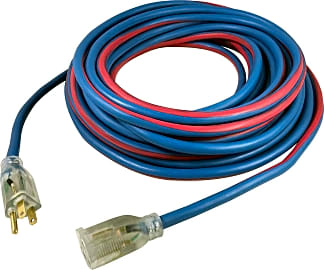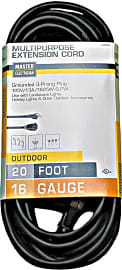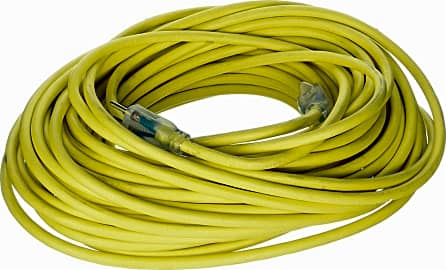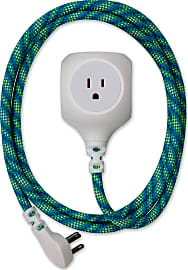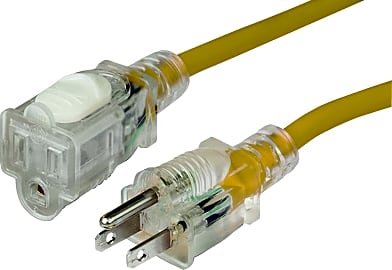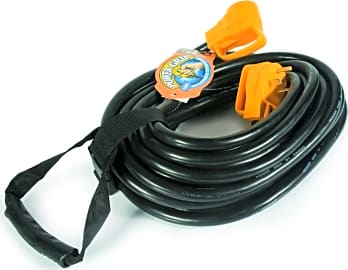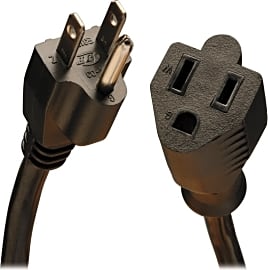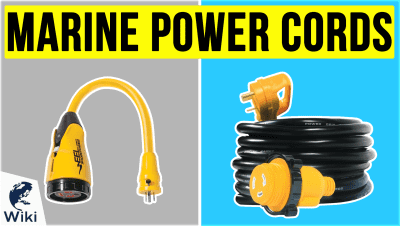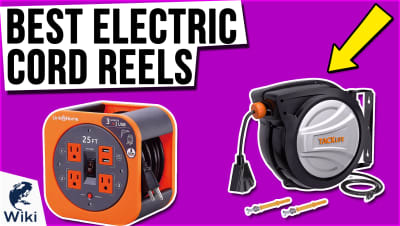The 10 Best Extension Cords

This wiki has been updated 38 times since it was first published in March of 2016. If you're positioning lighting and electronics in your home or office, running power tools in the garage, or using landscaping equipment in the back yard, you'll almost certainly need one or more of these extension cables to keep everything powered up. We've included models good for indoor use as well as some that are perfect for outdoor applications due to resistance to cold, heat, and chemicals. When users buy our independently chosen editorial selections, we may earn commissions to help fund the Wiki.
Editor's Notes
May 07, 2021:
At first thought, extension cords might seem pretty straightforward, and like they're all basically the same, but that's definitely not the case. Our goal with this Wiki has always been to present the best of the best in the widest range of varieties, and we believe that the list has something for almost everyone. We recommend the Iron Forge Cable Y25 for general outdoor use, because it's reasonably flexible but still highly safe and reliable in the long term. If you want something even more heavy-duty, the US Wire and Cable 99050 is probably the right choice.
On the other hand, if you're looking for something to use indoors, the 360 Electrical Accent is effective and looks far better than the average insulated extension cord, although it is a bit pricey. The Woods SlimLine 2232 is the right choice if you're looking for a combination power strip and extension cord. In terms of specialty cables, the Camco PowerGrip is our top heavy-duty 30-amp model and the Marinco 15A our favorite marine-rated option.
March 31, 2020:
It's of prime importance to select the appropriate extension cord for your needs, as the wrong one can result in disaster. If you're working in adverse conditions, the US Wire and Cable 99050 is almost impossible to beat, and the US Wire & Cable 74100 is a close second. The main difference between the two is their temperature rating, but they're both safe choices for a huge range of use cases. The Iron Forge Cable Y25 is particularly versatile thanks to its reasonable price, flexible construction, and optional three-way female end, and the Master Electrician 02352 is designed specifically for outdoor use, so you can leave it powering outdoor features without worry. The Prime Wire & Cable Medium Duty strikes a balance between load ratings and flexibility, which makes it great for powering lawn equipment as it's not too much of a burden to drag around behind yet won't be damaged by regular contact with rocks and sticks. The Marinco 15A meanwhile, is purpose-built for marine use and features a dependable locking switch to make sure you stay safe around water. On the other hand, if you want maximum convenience, consider investing in a power cable reel.
On the indoor front, the 360 Electrical Accent is both convenient and good-looking, but if you want something a bit more utilitarian, go for the Coleman Cable 03518. The Tripp Lite P022 is another excellent indoor option, though it's not ideal for large appliances.
Special Honors
Grainger If you're working in the commercial sector and need the best in electrical equipment, Grainger's wide selection likely includes exactly what you're looking for. Of particular note are their industrial grade extension cords with outlet boxes, which are common sights at job sites and professional venues of all types. grainger.com
The Importance Of Power
It's impossible to overlook this pervasive influence on humanity.
Electricity has changed the world in innumerable ways. It was named after the Greek word for amber after the ancients discovered that magnetism was generated when they rubbed two pieces of the stone together. And while rocks and eels have demonstrated its existence for millennia, it was only about 400 years ago that scientists would begin to theorize on the empirical aspects of the then-misunderstood concept of electrical charge. Ever since Ben Franklin made a shocking discovery with a wet string, a key, and a kite during a lightning strike, electricity has taken the scientific realm by storm. And researchers across the world have used this incredible phenomenon to create impressive technology.
The electricity that powers the several-nanometer-thick circuits in today's fastest chips is the same stuff that lit up the first powered homes in the late 19th century. The force that ignited the fuel of the earliest automobiles is, ultimately, the same one that is produced by the thousands of megawatts at nuclear plants across the world.
It's impossible to overlook this pervasive influence on humanity. Access to indoor lighting let humans take advantage of all hours of the day and night, increasing productivity. In fact, this led to the reduction of a popular phenomenon in civilized society called segmented sleep that people naturally employed to make it through the useful dark hours. Life-essential services like air conditioning and heating keep people safe and healthy, and they usually need to be plugged in. Similarly, electric refrigeration and cooking methods like freezers and microwaves have revolutionized the food game for chefs, families, and college students alike.
So what, exactly, is electricity, and how does it get from a from a huge, steam-driven turbine to your toaster at home?
Why All The Negativity?
Every piece of matter (that we know of, at least) is made up of negatively charged electrons orbiting a nucleus comprised of protons and, usually, neutrons — positively and neutrally charged particles, respectively. Electrical charge occurs when electrons are floating free of the strong bonds that normally keep them adhered to an atom. Substances susceptible to electrical charge are noted by their available valence electrons, which are free to move in and out of the outer ring of electrons orbiting the nucleus. When multiple such conductive atoms are located close together, as in a wire, that charge is able to move from molecule to molecule along a completed circuit. This flow is what we call electricity.
When multiple such conductive atoms are located close together, as in a wire, that charge is able to move from molecule to molecule along a completed circuit.
One interesting note is that despite all the technological advancements of the last century, some of the most popular and cutting-edge methods of energy production rely on the same principle as some of the earliest engines: steam power. From old-school, high-pollution coal plants to modern, somewhat intimidating nuclear facilities, all of this large-scale technology is used primarily to heat water. That steam spins a massive turbine, powering a generator and beginning the chain reaction of free electrons pushing one another all the way to your home.
Of course, that current goes through a few steps before it reaches your home. It's packed into overhead power lines at extremely high voltages to limit the energy lost as it travels down the wires. When the charge reaches the vicinity of its destination, like a neighborhood or an office building, it runs through a set of transformers that break it down into usable levels, usually between 110 and 240 volts. At that point, it's routed through distribution lines to each home and business's electricity meter, through a circuit breaker, and ultimately to wall outlets throughout the building. And that's where electrical wiring becomes the consumer's responsibility.
The Right Cord For The Job
Most municipalities enforce building codes that ensure that each room in a house has a minimum number of outlets a certain distance from one another. While this is a threshold requirement, there are many situations where appliances both small and large don't have the cord length to quite reach the wall plug. Some of these devices are simple and don't use much power, like a floor lamp or small fan. These might only need light-duty extension cords with only positive and negative wires. A lot of these cords are thinner and more flexible than heavy-duty models, making them perfect for use in the office or living room.
Most municipalities enforce building codes that ensure that each room in a house has a minimum number of outlets a certain distance from one another.
High-powered appliances, especially those with heating elements or large fans, will often require grounded plugs. The third prong on a grounded outlet sends excess power straight into the Earth in case of a power surge, preventing possible disaster in the event of a short circuit. It's critical to the safety of the user and the equipment to use a grounded outlet whenever you're using power tools or surge protectors.
It's also important to plan for where you'll be using the cord. Some units have great features, like multiple three-prong plugs, but aren't necessarily designed to be used outdoors or with heavy-duty equipment. As a rule, the thicker the cable, the more power it can handle. The most durable, high-quality options available have features like 12-gauge wire, multiple outlets, and high-impact, weather-resistant insulation. The durability of the protective covering on an extension cord is of particular concern if you'll be using it in the yard and garden or any kind of adverse conditions. Additionally, some models can be tucked away in landscaping or furniture arrangements thanks to their inconspicuous green, brown, or black coloring. Other, brightly colored orange or yellow cables are better for maintenance and on-the-job use because of their high visibility.
At first glance, it might seem like an extension cable is just an extension cable, without much variance. But there are plenty of specialized options with different purposes, and one of them is certain to fit your exact needs.


